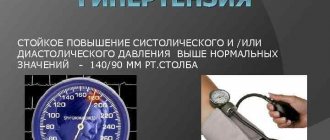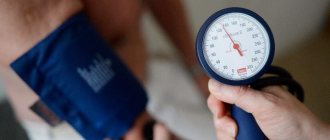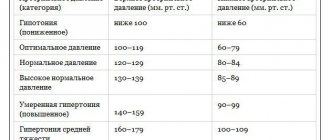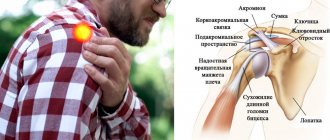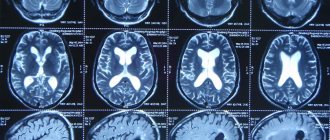A blood pressure of 100 over 70 in an adult, teenager, child or elderly person may be normal. If the tonometer shows such numbers constantly, and you do not feel any health problems, then this is your normal blood pressure. But if side symptoms appear in the form of weakness or dizziness, and such indicators are new to you, then this is low blood pressure. What does it mean and should I worry? Low blood pressure is not always a sign of illness, but it is worth taking safety precautions and also finding out why the pressure has become 100 over 70.
What does it mean if blood pressure is 100 to 70 mmHg? Art.?
Blood pressure is an indicator of the functioning of the cardiovascular system. Blood pressure can be used to judge the strength of blood impulses and resistance to vascular flow. The pulse is also indicative - how often a person’s heart pumps out blood. Normally, the heart rate is 60-80, but if the pulse is 90 or higher, then this is an anomaly. Together with low blood pressure, these signs may indicate pathology. Is 100 over 70 normal pressure in special cases? Yes, blood pressure can remain at 100 to 70 under the following circumstances:
- Children's age from three years.
- A trained body - athletes do not have high performance, but after training the indicator increases temporarily.
- Girls with a thin build, less often young people.
In older men and women, during pregnancy, these indicators are lower. You need to find out what pressure is 100 over 70 – what does it mean.
In a healthy person
The normal blood pressure for an adult who does not suffer from hypertension is 110-130 over 75-86. Why did the pressure drop in the absence of pathology:
- Low readings in the morning due to lack of sleep.
- Small intake of food into the body, lack of vitamins and other nutrients.
- Taking medications with a side symptom in the form of lowering blood pressure.
- Vegetovascular dystonia.
- Minor blood loss (sometimes blood pressure drops in girls during menstruation).
There is no need to immediately try to raise your blood pressure with pills, just restore your usual healthy lifestyle.
Self-medication with medications can be dangerous. The doctor will tell you how to increase blood pressure after studying the tests and conducting an examination.
In hypertensive patients
A jump from the usual 150 to 95 to 100 to 70 is a serious phenomenon for a person, which is not without symptoms:
- Weakness, dizziness.
- Headache.
- Vomits and feels sick.
- Cold sweat.
- Decreased blood supply - poor skin, cold extremities.
- Loss of coordination.
- The vision becomes cloudy and black spots appear.
A sharp decrease in blood pressure in a hypertensive patient can even lead to loss of consciousness. If you have a headache or no strength, do not ignore the symptom of low blood pressure, but seek help and raise your blood pressure levels.
When the pulse is more than 90
Pressure 100 over 70 and pulse above 90 are symptoms of tachycardia. When the number of heart beats per minute increases, a person may feel pain in the chest, pain in the left or right side of the head, and severe dizziness. This is not normal, and the side symptoms of tachycardia cannot be ignored.
Low blood pressure and pulse 101 require medical attention. Call an ambulance immediately if you feel signs of illness.
For pregnant women, the combination of tachycardia and blood pressure 100 over 70 is a common occurrence. In pregnant women, this is caused by hormonal changes, but this condition must be monitored. With prolonged high heart rate and low blood pressure, the risk of complications is high. A woman’s well-being should be monitored by a doctor.
What is normal pressure
The generally accepted norm for blood pressure (BP) is 120/80 in adults and adolescents over 15 years of age. If the tonometer shows 100/70 or 100/60, this is already considered a sign of hypotension. For children, such indicators are considered normal if the child is under three years old. Women often record their blood pressure as 100/70 and have no complaints about their health, but for men the minimum threshold is higher - approximately 110/75.
As the body grows and ages, the tonometer readings normally become higher and higher, so if the device shows 100/70 in an elderly person, this indicates diseases of the cardiovascular system. For another category of people, 100/70 is a normal indicator: athletes. Regular physical activity contributes to a complete supply of oxygen to the blood and stable functioning of the heart and blood vessels.
When playing sports, the heart muscle is trained, the pulse increases, but returns to normal on its own after the end of the exercise. To measure your own blood pressure and understand whether it is normal for a person’s age, you must comply with the following conditions:
- measure blood pressure in a calm environment, do not talk, do not laugh, do not touch the cuff and tubes of the device with your hands;
- a person should not feel hungry or want to go to the toilet;
- Do not drink drinks containing caffeine before measurement - then the results will be unreliable;
- after the measurement, compare the results obtained with heart rate indicators (if the pressure is normal or slightly below it, and the pulse is above 90 at rest, this is a sign of a problem).
So, for each gender and age, blood pressure standards are different. But today we need to talk about why the tonometer readings remain at 100/70, whether this condition is dangerous, and in what cases it is considered acceptable.
Causes of pressure 100 to 70
Every person has their own norms and deviations. If 100 to 70 is not a familiar phenomenon for you, you are more comfortable with a tonometer reading of 120 to 79, then look for the reasons for the decrease. Blood pressure may drop in the following cases:
- Vegetovascular dystonia.
- Blood loss, internal injuries with ruptures.
- Stress factors.
- Hereditary predisposition.
- Lack of physical activity.
- Change of climatic conditions.
- Traumatic brain injuries.
- Pinching of the spine, mainly in the cervical region.
- Diseases of the kidneys and adrenal glands.
- Chronic insomnia.
- Taking medications that lower blood pressure.
- Unbalanced diet.
- Strict diets, rapid weight loss.
- Atherosclerosis, thrombosis and other problems with blood vessels.
A pressure of 100 over 70 as an indicator of pathology may at first be the only symptom. But if the disease progresses, other health problems will begin to appear. Pay attention to any changes, and then you will detect the problem at an early stage of its occurrence.
Dangerous consequences of hypotension
Mild options, for example the already described blood pressure level of 100/70, are not so dangerous. However, this is not an axiom. Reduced tonometer readings always carry some risk.
What consequences for life and health can develop as a result of constant hypotension:
- Early dementia as a result of impaired tissue trophism on the one hand and constant surges in blood pressure on the other. A similar scenario is likely with constantly low blood pressure. The symptoms are similar to those of Alzheimer's disease in old age, but it is necessary to distinguish between these two conditions.
- Fainting, syncopal and collaptoid states. Danger of possible injury. A pathological drop in blood pressure can catch a person at the most dangerous moment: on the road, when climbing to the floor.
- Stroke. As a result of a sharp jump in blood pressure during physical activity. Carelessness can result in rupture of a blood vessel in the brain.
- Heart attack. A process accompanied by a violation of the trophism of the heart muscle.
Here are just a few possible complications. Therefore, you cannot delay going to the doctor, even if it seems that everything is fine.
Is blood pressure 100/70 dangerous?
The danger of low blood pressure is the tightening and decreasing elasticity of the walls of blood vessels. Already at a pressure of 105 over 74 we can talk about hypotension, which can lead to a crisis. Hypotonic patients are more difficult to tolerate such conditions, and the effect if timely assistance is not provided can be fatal.
With prolonged pressure of 100 to 70, heart disease develops. Thrombosis, atherosclerosis, stroke, heart attack are what cause low blood pressure. An additional danger is posed by a pulse of 94-99; tachycardia increases the load on the vessels, which may not be able to withstand it.
Symptoms
Signs of hypotension:
- drowsiness;
- weakness;
- deterioration of concentration and memory;
- decline in performance;
- emotional instability;
- dizziness, tinnitus and darkening of the eyes;
- dyspnea;
- sweating;
- migraine;
- nausea, sometimes vomiting;
- numbness and feeling of freezing in the limbs;
- pale skin.
Separately, it is worth noting the weather dependence, which is also typical for hypotensive patients.
What to do?
When the pressure becomes constant at 100 over 70, but you do not feel comfortable due to a rapid heartbeat, then look for the cause of the decrease and eliminate it. But first, take a reclining position and calm down, massage the tips of your ears, this will increase blood flow. This will help raise your blood pressure to about 104 over 76. If you drink strong black tea with sugar or a little coffee, your readings will increase even more. At home, these actions are enough to increase blood pressure to 107 over 77, which is already close to normal.
What is the danger of hypotension?
Low blood pressure has both immediate and delayed dangers.
With a lack of oxygen, heat, stuffiness and motion sickness, fainting can occur. If you feel dizzy and have a premonition of losing consciousness, you need to take a horizontal position so that your legs are higher than the level of your heart, for blood flow to the brain. Chronic fatigue can lead to decreased alertness, which can lead to risks when driving and operating equipment.
Over time, hypotension can progress to hypertension. This is due to the potentially low elasticity of the vessels, because over time they may become stiffer, and there will be a problem not only with increasing tone, but also with decreasing and relaxing during spasm. Also, hypotensive patients tolerate hypertensive crises worse, the symptoms of which may be at lower levels than in hypertensive patients.
Over time, hypotension can progress to hypertension
Troubleshooting at home
Hypotonic patients should consume at least two liters of clean water per day, this will help maintain the blood in a normal fluid state. It is also recommended to drink one glass of dry red wine or drink a little black tea or coffee. Taking medications when the readings are 100 to 70 is not always appropriate. Good nutrition and physical activity, strengthening the body with sports will quickly bring blood vessels and the heart back to normal. Treatment of hypertension without proper sleep is impossible.
Additional measures to increase blood pressure can include:
- Taking vitamin C. It is found in cabbage, citrus fruits, parsley, spinach, cranberries, strawberries, broccoli, and tomatoes. Vitamin C has a beneficial effect on the adrenal glands, causing them to produce more adrenaline, which will increase the tonometer readings.
- Taking licorice root will allow you to produce hormones more freely, but the risk of swelling increases.
Do not overuse teas and herbs, try to balance your daily diet and this will be enough to raise your blood pressure to 102 to 72.
If you suffer from hypotension in the morning, then sleep at night on a high pillow, so there will be no sudden changes in pressure.
How to increase blood pressure
If you have a single fall, you can drink a caffeine-containing sweet drink - coffee, green and black tea with 1-2 tablespoons of sugar.
You should not drink energy drinks, because the compounds in caffeine, sugar and taurine can cause an excessive jump, especially against the backdrop of weak blood vessels. You should eat, preferably easily digestible and carbohydrate foods - whole grain bread, cereals, fruits. Moderate physical activity, especially swimming, running, cycling, has a good effect on vascular tone and general well-being.
It is possible to take medications to help withstand stress. These can be herbal remedies of valerian, motherwort, and eleutherococcus. They can also help adjust your sleep patterns.
If you have problems with blood pressure, you should monitor your readings yourself using a home blood pressure monitor. If necessary, you should consult a doctor for recommendations on what to do in case of various changes.
Diagnostics
Diagnostic measures to identify hypotension begin with interviewing the patient. A therapist or cardiologist will ask about changes in tonometer readings over a long period of time and ask about current symptoms and general well-being. Examines the patient and measures blood pressure. After this, the doctor may order several or all of the following tests:
- Cardiogram.
- Echocardiography.
- General blood analysis.
- Blood chemistry.
- Angiography.
- Radiography.
- Ultrasound of the heart.
- Daily blood pressure monitoring.
After establishing the causes of low blood pressure, the doctor will prescribe therapy.
About the variability of pressure
Blood pressure changes throughout the day. It depends on the time of day, and on physical activity, and on food intake, and on the climate - this is an indicator that can adapt to changing conditions. Therefore, the key point when measuring blood pressure is the frequency of measurements.
Here's what the medical instructions say:
- If the first two blood pressure measurements differ from each other by no more than 5 units, measurements can be stopped, and the average value of the two measurements should be considered the blood pressure marker.
- If two measurements yield numbers that differ by more than 5 units, you need to repeat the procedure again. And if necessary, carry out a fourth measurement. If such a cycle reveals a progressive decrease in blood pressure, then the patient should be given time to relax. If multidirectional changes are noted, subsequent measurements are stopped and the value is recorded by averaging the last three measurements.
If the patient has atrial fibrillation, the procedure should be carried out using a special device with high-speed measurement technology.
Prevention measures
Preventive measures are good for maintaining the body during hypotension and preventing it:
- Proper nutrition, do not abuse fast food.
- Healthy sleep.
- Reducing stress factors.
- Balancing your lifestyle - reduce excessive stress (mental and physical) or add if there is insufficient stress.
- Drink strong tea or coffee in the morning, a little during the day.
- Spend more time outdoors.
- Eat chocolate, dark.
It is better to constantly keep the body in good shape and monitor the functioning of the cardiovascular system than to take pills afterward. A pressure of 103-106 to 73-78 does not require drug treatment in the absence of tachycardia, so do not start therapy on your own.
How to deal with the problem
If the tonometer display shows 100/70, but your heartbeat and general health are normal, you don’t need to do anything.
If a regular decrease in blood pressure does not have any apparent reason and is accompanied by weakness or dizziness, you can use simple techniques to raise it and improve your well-being.
And also read on our website what to do if your blood pressure is: 100 over 40, 100 over 50, 100 over 60 and 100 over 100?
What to do to correct hypotension yourself:
- Tea made from juniper, rose hips, raspberries, and currants strengthen the body and bring arterial tone back to normal.
- Strong coffee also successfully fights hypotension: one cup of the drink relieves weakness and drowsiness and gives energy. However, you should not drink more than 3 cups of coffee per day. Bananas, nuts, and dark chocolate have the same properties.
- For constant stress and high psycho-emotional stress, it is recommended to use sedatives based on medicinal herbs.
- A contrast shower will help tone your blood vessels in the morning.
- Regularly sitting at a desk for 8 hours a day provokes a loss of strength and a decrease in blood pressure. A short walk in the fresh air during your lunch break will help you cheer up.
- Lack of night sleep also takes away strength and impairs performance. Scientists have found that for normal functioning of the body, men need at least 7 hours of sleep, women - 9 hours.
- With low blood pressure, doctors advise increasing the amount of salt consumed to 9 g per day, with the norm being 6 g.
- A nutritious diet with balanced nutrients helps to cope with the problem of loss of strength and poor performance, while disordered eating of “empty” foods provokes hypotension.
- It is useful to periodically use vitamin complexes, as well as tonic preparations based on herbal components: eleutherococcus, radiola, echinacea, ginseng.
- Celery root and strawberries will help pregnant women normalize blood pressure.
And also read on our website: What do pressure readings of 140 over 60 mean, is this normal, why is it dangerous and what should the elderly and pregnant women do?
In the fight against hypotension, it is important to ensure the flow of fresh air into the room. If this is not possible, you need to take short breaks every 1–2 hours and go outside or to an open window for a few minutes.
There are drugs that tone the walls of blood vessels, stimulate their contraction, thereby causing hypertension. Taking such medications without a doctor's prescription is strictly prohibited!
If low blood pressure bothers you for a long time and is difficult to correct using the methods described above, you should consult a doctor. Hypotension may be a symptom of a serious illness. Treatment of the underlying pathology will lead to normalization of blood pressure.


